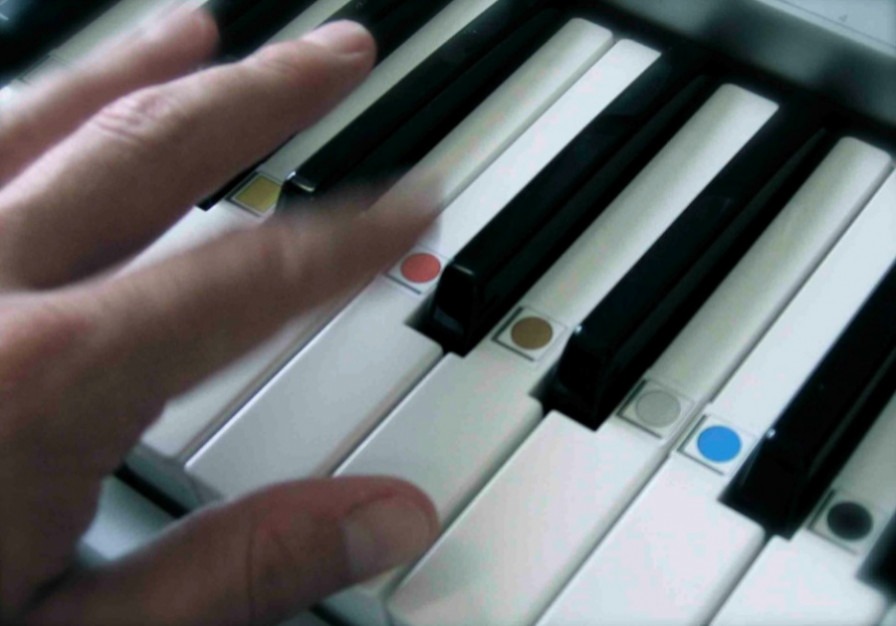Interview with Pete Sparkes from 'Drake Music Scotland'

As part of my research of the wonderful music notation system 'Figurenotes' I interviewed Pete Sparkes, artistic director at Drake music Scotland. Pete was kind enough to give me lots of feedback about his experience of using Figurenotes and other approaches to music making in education / SEN settings. Thanks Pete!
Q: I have used Figurenotes flash cards as a visual aid when introducing the system to a group of workshop participants with learning disabilities. I line the notes from the key of C major on the floor and as the participant steps on each card I play them the corresponding note of the scale with an instrument and then the whole group attempts to pitch it correctly and sings it back as an echo. Do you have any activities you use to introduce the system to learning disabled students?
A: We do similar things with magnets on a white board, using individual chimes and matching those to colours and shapes that are chosen. Any activities that involve choosing your own order can be quite creative but important to also review and ask students if they want to change the order or move any notes around. Using chimes or a keyboard can make pitching the notes easier as singing and pitching from Figurenotes colours could be very difficult for some learners. We have also had some fun using Figurenotes dice and ‘fortune teller’ resources – these are available from the figurenotes community –
http://www.drakemusicscotland.org/figurenotes/figurenotes-community/reso...
Q: Figurenotes software enables you to create musical scores using figurenote symbols. Use of the software has been very useful for me to notate original compositions for our project. I have not yet explored making the software available to students. Have you much experience using the software with students with learning disabilities?
A: Yes – this can work very well but students need support using the software. Seeing the red line move along the score as it plays can really help embed the idea of the steady beat through each bar that you need to have in order to play in time. It can also give students great confidence and a better understanding of what composing is – essentially making choices from a series of options. We find the keyboard layout at the top of the software a useful conceptual link to the actual instrument that they might be playing.
Q: I heard the software package has been updated recently and includes a new figurenotes colour purple? Can you tell me what to expect from the new features of the software
A: That was an April fool!! We are working to improve text input using text boxes and also a new triplet/duplet feature. Also being able to input expression marks. This is all still in development.
Q: the tools such as the Figurenotes dice and fortuneteller are very useful for helping to generate musical ideas and practice using Figurenotes. Do you have any particular strategies for working on pitch and rhythm recognition using Figurenotes?
A: Using unturned percussion and very simple rhythm games – flash cards are useful. Teaching simple rhythm games by call and response and then introducing the same rhythm games using figurenotes flash cards will help to show students what a rhythm that they already know looks like in Figurenotes.
Q: I have explored the Figurenotes resources and songs that have been notated and made available on the Drake Figurenotes webpage. The first piece I notated for use with my students was the James Bond theme, I found teaching it had an instant impact because students seemed to enjoy learning a familiar tune. Do you have any favourite songs for using in settings with learning disabled students?
A: Difficult question really as groups are so different in ages and tastes. The best thing about Figurenotes and the driving force behind our desire to create software was the idea that each person could learn tunes and songs that mean something to them – either because they already know and love the songs or they have written the music themselves.
Q: I heard that teachers at 'Ressonari' in Finland had used strings of beads in the respective figurenote colours of scale to aid the teaching of scales to students. Are there any other strategies of using figurenotes you have heard of that are interesting?
A: Using colourful paintings as a kind of graphic score to inspire music can be fun. We have also made cakes with smarties on top using only the smarties that have Figurenotes colours – if you can play the four note tune on your cake you can eat it! Really anything that involves colour can be explored – lots of opportunities with visual arts and films, using PowerPoint displays to fill a screen with colour can also really help things like repeated Chord patterns.
Q: I have experimented with aspects of Kodaly method, Solfege and Eurhythmics as part of my practice. Asides from Figurenotes are there any other practical strategies for teaching music that you have explored/heard of that interest you?
A: I think that ‘Musical Futures’ is worth looking at – it is not so much a strategy as a method of teaching music using rock & pop rather than the more traditional ‘western classical’ methods that tend to be used in Music Departments – although this is definitely changing for the better!
Pete Sparkes (drake music scotland) was interviewed by Sam Dook (Carousel) 10/2015
